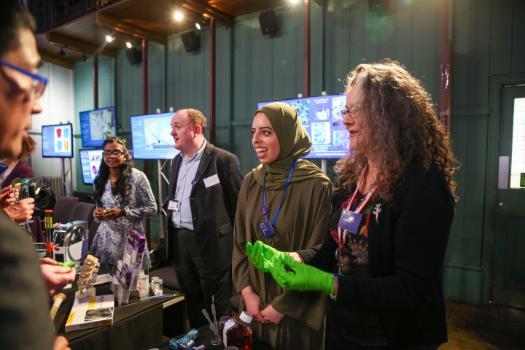
Creating a more sustainable future
At a glance
- Queen Mary researchers are developing practical solutions to the climate and nature crises.
- We are uncovering the impact of microplastics on our health, a vital first step towards effective regulation to protect public health worldwide.
- We are building new advanced materials for more sustainable manufacturing,such as to reduce plastic and improve energy efficiency.
- We are bringing clean energy to remote communities with low-cost, distributed systems and new converters.
Understanding the impact of microplastics on our health, with WRc
Every day we eat food and drink water contaminated with microplastics – tiny plastic debris from the disposal and breakdown of consumer products and industrial waste. What is this doing to our bodies?
We’re partnering with the Water Research Centre (WRc Group) to examine the impact of microplastics on human health. Our team, led by Dr Vahitha Abdul Salam, is analysing samples using state of the art instruments for detecting microplastics and associated chemicals and running tests in both human tissue and computer models.
It is critical that we understand the true risks of microplastics to our health. This pioneering research is the next step in developing comprehensive risk assessment and effective regulation.
“Innovation is at the heart of everything we do at WRc, and our exciting research into microplastics is no different. This will lift us from a world with no standard protocols for microplastic risk assessment…to a world with set safe concentrations of microplastic in drinking water.” Andy Blackhall, MD, WRc

Turning waste grain into alternative leather, with Arda BioMaterials and Kings College London
The environmental footprint of leather is enormous. Yet with most vegan leathers being essentially plastic – they are not great for the planet either.
Another alternative is the waste grain from beer brewing; the grain’s unique protein and fibre content can be utilised to produce a leather-like material. However, the material lacks the corium, leather's fibrous underlayer, which is crucial for its structural integrity and distinctive texture.
Plastic leathers tend to use petroleum-derived fibres that when spun together create the key layer that makes leather so useful. Dr Dimitrios Papageorgiou is working with Arda Biomaterials and Kings College London to do the same with brewers’ spent grain.
We’re creating high-performance electrospun fibres out of the unique protein content of brewers' spent grain and using these to produce a fibre layer that we’re integrating with the current leather-like material produced by Arda Biomaterials.
Unlike other spinning techniques, electrospinning does not require high temperatures, making the technique particularly well suited for proteins. Furthermore, electrospinning has proven scalability.
The unique composite product is wholly biodegradable and traceable – unlike plastic-based alternative leathers.
Fittingly, the main use for spent grain today is to feed livestock – so you could say we are cutting out the middle cow.

Finding alternative components for energy efficient products, with Paragraf
Many energy-efficient products rely on Indium, a metal which is rapidly becoming scarce. It’s one of the most expensive materials on the market and has significant price volatility.
Graphene has long been lauded as an alternative – a sustainable material with the necessary properties of high electrical conductivity, high transparency, and ease of disposition.
In practice it’s been hard to scale up production in the sizes and quantities needed.
Through our partnership with Paragraf, we’ve contributed our expertise to study and develop a wide range of graphene devices without compromising the essential characteristics needed for electronics manufacturing.
“Graphene is an extraordinary material that offers incredible potential in the world of electronics, not least in the replacement of expensive, extremely environmentally unfriendly device contact layers. This exciting project between Queen Mary and Paragraf has the opportunity to revolutionise the industry and provide a safer, more cost-effective, renewable solution for electronics.” Dr Simon Thomas, Founder, Paragraf

Transforming energy access, with EcoWave Power
Many energy-efficient products rely on Indium, a metal which is rapidly becoming scarce. It’s one of the most expensive materials on the market and has significant price volatility.
Graphene has long been lauded as an alternative – a sustainable material with the necessary properties of high electrical conductivity, high transparency, and ease of disposition.
In practice it’s been hard to scale up production in the sizes and quantities needed.
Through our partnership with Paragraf, we’ve contributed our expertise to study and develop a wide range of graphene devices without compromising the essential characteristics needed for electronics manufacturing.
“Graphene is an extraordinary material that offers incredible potential in the world of electronics, not least in the replacement of expensive, extremely environmentally unfriendly device contact layers. This exciting project between Queen Mary and Paragraf has the opportunity to revolutionise the industry and provide a safer, more cost-effective, renewable solution for electronics.” Dr Simon Thomas, Founder, Paragraf

Key takeaways
- Industry collaboration helps us to achieve more real-world impact from our research.
- By working with Queen Mary, you benefit from leading expertise who can help give you a competitive edge in the green industrial revolution.


